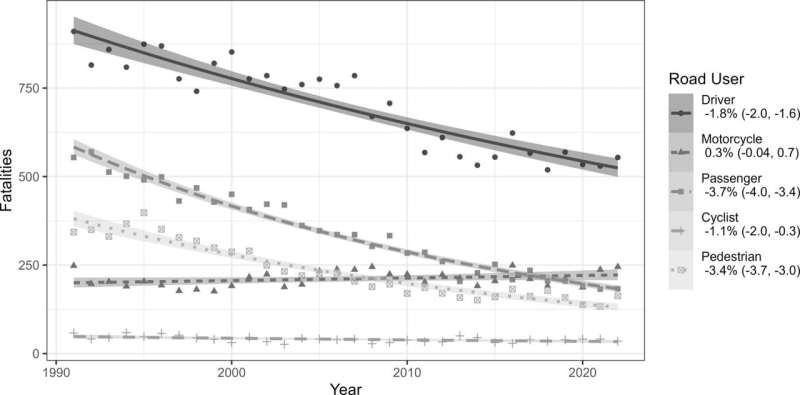This article has been reviewed according to Science X's editorial process and policies. Editors have highlighted the following attributes while ensuring the content's credibility:
fact-checked
peer-reviewed publication
trusted source
proofread
Cycling deaths on the decline in Australia, but not in all age groups

New research shows there is a stark contrast between fatality rates in younger and older cyclists in Australia.
Cycling deaths are slowly declining in Australia, but fatalities involving single riders and older people are on the rise.
Analysis of the 1,294 cyclist fatalities recorded in Australia over the last three decades shows cycling deaths slightly decreased overall by an average of 1.1 percent annually. However, fatalities in those aged 60 years and over increased by 3.3 percent annually over the same period.
The research, conducted by scientists from UNSW Sydney and published in the journal Injury Prevention, also shows a significant increase in single-vehicle cycling deaths—fatal accidents involving cyclists just by themselves. The number of single bicycle fatalities increased by 3.7 percent per year for all cyclists and 4.4 percent per year for those aged 60 years and older.
"The results of this study show a stark contrast in trends of cycling fatalities between those aged less than 60 years and older age groups, particularly for single-vehicle fatalities," says lead author of the study, Associate Professor Soufiane Boufous, injury epidemiologist and Director of UNSW's Transport and Road Safety Research Centre.
For the study, the researchers analyzed trends by age in national cycling fatalities recorded between 1991 and 2022 from data reported by the police to state and territory road safety authorities.
Adjusting for population, mortality rates per 1,000,000 showed an annual decrease of 3.5 percent for cyclists under 60 years. Meanwhile, deaths increased by 0.5 percent annually in the over-60 group over the study period.
"The rise in cycling fatalities among those aged 60 years and over seems to be related to the aging of the population rather than an increase in cycling participation," A/Prof. Boufous says. "Though one of the challenges is we don't have a lot of great data on just how many people are cycling."
The proportion of cyclist fatalities for over 60s in Australia increased from 8.6 percent of all cycling deaths in 1991 to 45.7 percent in 2022.
"Part of it is older people are frailer, so if they do have an accident, they're more likely to sustain and die from serious injury," A/Prof. Boufous says. "Older cyclists may also be more likely to underestimate the likelihood of severe injuries due to single-bicycle crashes, so it is essential to raise more awareness of these risks."
When examining trends in the number of older cyclist deaths by crash type over the study period, those that occurred following single-vehicle crashes increased by 4.4 percent year on year, more than double the annual rate of increase in older cyclist deaths from multiple-vehicle crashes at 2.0 percent.
"During the 1990s, about 1 in 10 older cyclist deaths in Australia were associated with single-vehicle crashes, while that figure has been nearly 1 in 3 since 2010," says A/Prof. Boufous. "It seems to reflect a worldwide trend that has also been observed in several European countries where cycling is more popular."
Quality of cycling infrastructure in Australia
The increase in older cyclist fatalities from single-bicycle accidents is likely related to the increased use and availability of dedicated cycling infrastructure built over recent decades.
"Segregated cycling lanes separate cyclists from motorists and reduce the likelihood of multi-vehicle cycling fatalities, but it doesn't necessarily reduce single-vehicle fatalities," says Professor Jake Olivier, co-author of the study and Deputy Director of the Transport & Road Safety Research Centre.
The quality of cycling facilities might also be partly to blame. Poorly maintained cycling lanes can force unprepared cyclists onto the road, where they lose control and sustain severe injuries.
"Just because there is an increased availability and use of dedicated cycling infrastructure doesn't mean all of it is necessarily good or well kept," A/Prof. Boufous says. "We also have very disconnected cycling networks where cycling lanes abruptly end and force riders onto dangerous stretches of road alongside motorists, and it's not uncommon to find debris or cracks along cycle paths."
Safety issues related to fear of sharing the road with motorists are among the top barriers for would-be cyclists, who identify more separated bicycle lanes as critical to encourage them to ride more frequently.
"Many hardy individuals continue to cycle despite less-than-ideal conditions for cycling in Australia," Prof. Olivier says. "But we also know many more would ride more often with better infrastructure and networks."
The researchers also recommend governments collect more data on cycling participation rates in Australia to help better plan for demand.
"The safety concerns need addressing if we want more people to cycle, and we should if we care about the environment, climate change, pollution and general health and wellbeing of the population," Prof. Olivier says. "To do that, we need more mobility surveys funded by the government to better understand the needs of cyclists and improve the design and maintenance of cycling facilities."
More information: Soufiane Boufous et al, Age, crash type and the changing patterns of cycling fatalities in Australia between 1991 and 2022, Injury Prevention (2024). DOI: 10.1136/ip-2023-045003




















